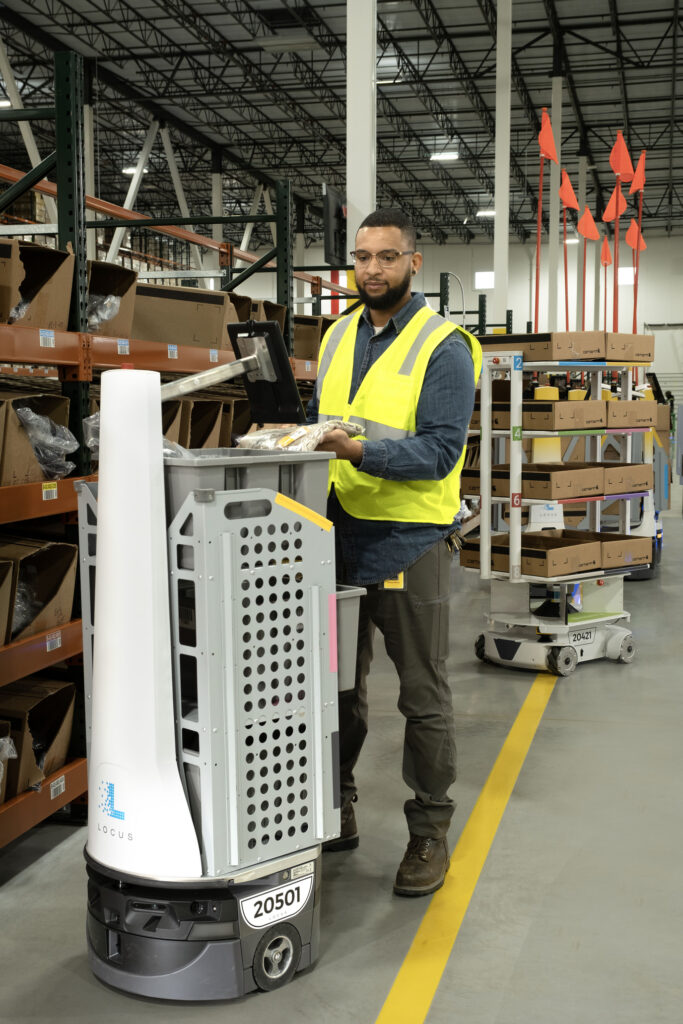Webinar Registration: The P2G Advantage
Webinar Registration: The P2G Advantage LEARN MORE
Fulfill More Orders and Optimize Warehouse Operations with AI and Robotics
Alex Selwitz, Director of Digital Marketing at Red Stag Fulfillment

The demand for swift and efficient order fulfillment is growing exponentially, along with the acceleration of the global economy. The eCommerce sector, in particular, is placing unprecedented pressure on warehouse operations to deliver goods rapidly and accurately to customers' doorsteps.
Consequently, integrating innovative strategies to optimize warehouse operations is of paramount importance for businesses. Achieving operational efficiency in the warehouse is critical to remain competitive, enhance customer satisfaction, and sustain business growth.
At the core of these strategic improvements lies the transformative power of automation. In essence, automation enables warehouses and fulfillment centers to overcome traditional operational challenges and streamline their processes to meet this escalating demand.
Let’s look at some of the applications of automation in warehousing, and the strategies to integrate the technology.
The Role of Robotics in Warehouse Optimization
Robotics plays a pivotal role in automating repetitive and labor-intensive tasks in a warehouse. These tasks can include picking, packing, sorting, and moving items within the warehouse, otherwise known as point-to-point (P2P) transport.
The application of robotics in warehouse optimization comes in various ways, each contributing to overall operational efficiency and accuracy. Here are some key areas where robotics bring transformative change:
- Picking and packing: Robots expedite the picking and packing process by quickly moving goods. They can work alongside humans to increase throughput and reduce cycle times.
- Loading and unloading: Robotic systems can perform loading and unloading tasks with superior speed and precision. This can reduce the risk of damage to goods and decrease loading times.
- Sorting: Sorting robots can swiftly and accurately categorize items based on parameters like size, weight, and destination. This leads to a reduction in errors and an increase in overall warehouse organization.
- Transportation: Autonomous robots can move items within the warehouse efficiently, minimizing the time taken and human effort required for intra-warehouse transportation.
In one warehouse, the implementation of robots transformed operations.
The integration process begins with mapping out the warehouse floor and programming the robots to navigate it. Each robot is equipped with a scanner that reads barcodes on the floor, enabling it to locate items in the warehouse. Once an order comes in, the robot locates the necessary shelf, lifts it, and transports it to a human worker who picks the required item.
The benefits have been significant: increased speed in picking and packing, reduction in errors, efficient space utilization, and the ability to operate continuously, increasing overall warehouse productivity.
Moving on, let’s explore some of the strategies that facilitate integrating various automation protocols into warehouse operations.
1. Leverage AI and ML for Optimizing Warehouse Operations
Artificial Intelligence (AI) and Machine Learning (ML) have specific implications in the warehousing services domain. They bring efficiency to warehouse operations by assisting in tasks like data analysis, forecasting, and decision-making.
The benefits in more detail include:
- Optimized inventory management: AI/ML can predict demand patterns and help maintain optimal inventory levels; this avoids overstocking or understocking and leads to cost savings.
- Accurate forecasting: Through trend analysis and demand prediction, AI/ML enables accurate forecasting that helps in planning inventory and warehouse resources effectively.
- Efficient demand planning: AI/ML can analyze historical data and predict future demand, enabling warehouses to plan their resources and inventory accordingly.
One leading eCommerce company in China has used AI and ML to drastically reduce its order fulfillment times. AI and ML algorithms analyze order data in real time, enabling the company to predict demand patterns and optimize inventory accordingly.
This ensures that popular items are always in stock and ready for quick dispatch. The ML algorithms also optimize the route for picking, reducing the time taken to locate and pick items. These factors combined have significantly improved the company’s order fulfillment efficiency.
2. Integrate WMS with Automation Technologies
Warehouse Management Systems (WMS) integrated with automation technologies can provide a comprehensive view of the entire warehouse operations, including real-time inventory tracking, efficient order fulfillment, and seamless communication between systems.
This integration helps warehouses operate smoothly, with reduced errors and improved operational efficiency.
An example of the successful integration of WMS and automation technologies is seen at one advanced automated warehouse.
In this setup, robots work alongside humans in a diverse facility with cage products, DEA products, pharmaceutical products, animal health products, and medical devices that ship out within the United States. This facility also features multiple freezers, and cooler
storage, which is 2 to 8 degrees Celsius. The system is controlled by a central AI-powered WMS that keeps track of inventory and orchestrates the robots' movements.
The automation technologies seamlessly interact with the WMS, ensuring real-time inventory tracking and efficient order fulfillment. Orders are processed at an unprecedented speed, with thousands of items packed within an hour. The facility also ensures nearly flawless accuracy in order picking, minimizing errors.
The successful integration of the WMS and automation technologies at this warehouse demonstrates the transformative potential of these technologies. It illustrates how they can enable companies to meet growing demand and achieve high levels of efficiency and accuracy in their operations.
3. Use Automation to Enhance Quality Control and Minimize Errors
Automation plays a vital role in enhancing quality control processes and reducing errors in warehouse operations. Automated systems can accurately track inventory, monitor product quality, and flag discrepancies, thus mitigating the risk of errors.
Automation enhances productivity and reduces errors in warehouse operations in several ways:
- Enhanced productivity: Automated systems can perform tasks faster and continuously, leading to increased throughput and productivity.
- Shorter cycle times: Automation speeds up warehouse processes, from picking and packing to loading and unloading, resulting in shorter cycle times.
- Intelligent layout planning: The technologies can analyze warehouse data to determine the optimal layout for efficient operations.
- Labor allocation: Automation can be used to determine where orders are clustered and allocate human resources appropriately.
4. Boost Reliability through Real-time Monitoring and Predictive Maintenance
Real-time monitoring in a warehouse setting typically involves the use of sensors and IoT devices that constantly track and report on various operational parameters, such as inventory levels, equipment status, temperature, and humidity. AI technologies analyze this data in real time, enabling warehouse managers to promptly identify and resolve any issues.
Predictive maintenance, on the other hand, uses AI and ML to predict potential equipment failures based on historical data and real-time information. The system alerts the maintenance team about the impending issue, enabling them to rectify it before it escalates into costly downtime.
Together, real-time monitoring and predictive maintenance increase the reliability of automated systems by minimizing downtime and reducing operational costs. In a warehouse setting, this could mean fewer order delays, improved order accuracy, and increased customer satisfaction.
5.Integrate Data Analytics and Predictive Modeling
Data analytics involves examining large sets of data to uncover hidden patterns and insights, which can aid decision-making.
Predictive modeling, a subset of data analytics, uses statistical techniques to predict future outcomes based on historical data. In a warehouse setting, these technologies are applied in several ways:
- Inventory management: Data analytics can provide insights into demand patterns, enabling warehouses to maintain optimal inventory levels.
- Order picking: Predictive modeling can help optimize the picking route, reducing the time taken to fulfill an order.
- Replenishment: By predicting when a particular item will run out, these technologies can automate the replenishment process, ensuring that the item is restocked before it runs out.
The integration of data analytics and predictive modeling leads to more efficient warehouse operations by minimizing inventory holding costs, reducing stockouts, ensuring timely order fulfillment, and enhancing overall operational efficiency.
Specific Automation Tools and Their Application
The following automation tools are instrumental in optimizing warehouse operations:
- Automated Storage and Retrieval Systems (AS/RS): These systems automate the storage and retrieval of items in a warehouse, increasing efficiency and accuracy. They also maximize space utilization, making them ideal for warehouses with limited space.
- Conveyor systems: These automate the movement of goods within the warehouse, reducing manual labor and speeding up intra-warehouse transportation.
- Autonomous vehicles: These vehicles can move items within the warehouse without human intervention, increasing efficiency and reducing the risk of accidents.
- Picking robots: These robots automate the process of locating and picking items, reducing human labor and increasing picking accuracy and speed.
- Sortation systems: These systems automatically sort items based on certain parameters, improving the organization within the warehouse and reducing manual sorting efforts.
The takeaways
Automation technologies hold immense potential in empowering warehouses to meet the growing demand. These technologies can significantly improve warehouse operations, making them faster, more accurate, and more efficient.
The benefits of embracing automation are undeniable: increased operational agility, reduced costs, and improved customer experience. These advancements are instrumental in meeting the rising expectations of customers and maintaining a competitive edge in the market.
It is high time for decision-makers in warehousing and logistics to embrace these technologies, and use the power of automation to optimize their operations, and ensure sustainable growth in an increasingly competitive market.
About the Author
Alex Selwitz is the Director of Digital Marketing for Red Stag Fulfillment, an eCommerce fulfillment warehouse that was born out of eCommerce. He has years of experience in eCommerce and digital marketing. In his free time, Alex enjoys playing guitar and learning about new trends in the digital world.




